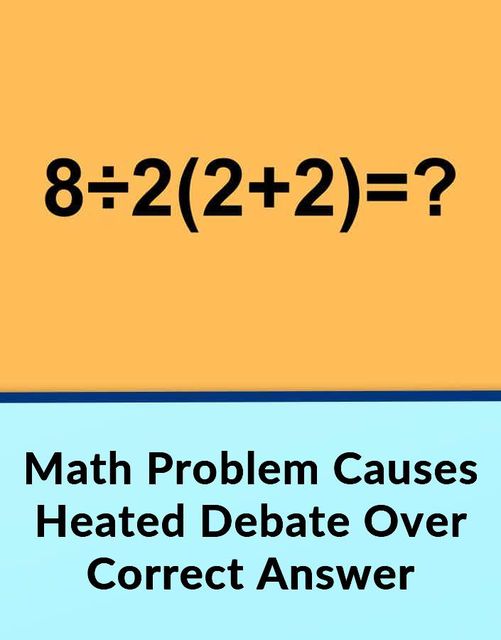The internet is no stranger to debates over puzzling questions, and from time to time, these viral controversies leave people completely stumped. Much like the infamous debate over whether a dress was blue and black or white and gold, a math problem posted on Twitter in 2019 had people from all walks of life—including mathematicians—scratching their heads and arguing about the correct answer.

The math problem in question is: 8 ÷ 2(2 + 2). What seemed like a simple arithmetic problem quickly became a full-blown internet debate, with people divided on what the correct answer should be. The discussion spread across Twitter, social media platforms, and even workplaces, drawing in both casual math enthusiasts and professionals alike.
The Equation That Divided the Internet
The viral math problem prompted editors from Popular Mechanics, a well-known lifestyle magazine, to debate the solution amongst themselves. The magazine’s team was split, with each side offering a different approach to solving the equation. On one side, some editors adhered to the basic math rule taught in schools: PEMDAS—an acronym for Parentheses, Exponents, Multiplication, Division, Addition, and Subtraction. This rule dictates the order in which mathematical operations should be carried out.
According to this method, the first step is to solve the expression inside the parentheses, 2 + 2, which equals 4. This leaves the equation as 8 ÷ 2 × 4. Under PEMDAS, multiplication and division are handled from left to right, meaning the next step is to divide 8 ÷ 2, which results in 4. Finally, multiply the remaining numbers: 4 × 4, which gives the final answer of 16.
This straightforward interpretation seemed logical to many people, as it followed the standard rules of mathematical operations. Even Mashup Math, an online math resource, supported this explanation, reaffirming that 16 was the correct answer.
The Alternative View: The Answer Is 1
However, not everyone agreed with the 16-solution. Another group of people, including some of the Popular Mechanics editors, argued that the answer was 1, not 16. They too used the PEMDAS rule but applied it differently, focusing on how the multiplication inside the parentheses should be interpreted.
In this alternative view, the equation is written as 8 ÷ 2(4) after solving the parentheses. Here, the multiplication implied by the parentheses takes precedence over division, meaning that instead of dividing 8 by 2 first, you should multiply 2 × 4 to get 8. Then, divide 8 ÷ 8, which gives the answer of 1.
This approach led to a completely different solution, and those who supported it argued that multiplication within parentheses should be handled first, even if it follows a division symbol.
Mathematicians Step In
As the online debate grew, mathematicians and scientists entered the fray to weigh in on the matter. Mike Breen, from the Public Awareness Office of the American Mathematical Society, offered some insight into the problem. According to Breen, the correct answer is indeed 16 when following the standard order of operations, PEMDAS.
However, Breen also acknowledged that the way the equation is written makes it “ambiguous,” leading to different interpretations. He admitted that while 16 is the mathematically correct answer, the argument for 1 wasn’t entirely invalid due to the ambiguity in how the problem was presented.
“In math, ambiguities can arise,” Breen explained. “Mathematicians work to make rules as precise as possible. According to strict order of operations, you’d get 16, but I wouldn’t fault someone for arriving at 1 based on a different interpretation.”
Physics Professor Offers Clarity
To further clarify the debate, Popular Mechanics consulted Physics Professor Rhett Allain from Southeastern Louisiana University. Allain compared the debate to differences in conventions, like how some people spell “gray” while others spell it “grey.” He emphasized that in both language and math, conventions exist to help us communicate clearly, but people can still interpret things differently.
Allain suggested that the problem could have been written in a clearer way, like 8 ÷ (2 × (2 + 2)), which would make the answer 1. This adjustment eliminates the ambiguity that caused so much confusion.
Conclusion
In the end, the controversy surrounding this math problem serves as a reminder that even something as seemingly straightforward as arithmetic can spark intense debates when interpretation comes into play. While the strict application of PEMDAS gives an answer of 16, the ambiguity in how the equation is written allowed for a second, competing answer of 1. The discussion reveals that clarity is crucial in math, and without it, even experts can disagree.





